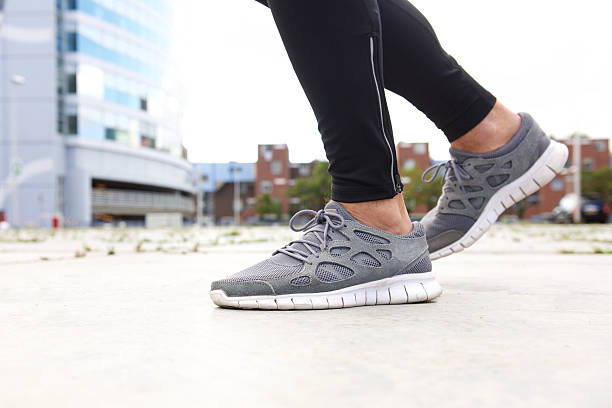The Difference Between Walking And Running Shoes: Things You Need To Know

Walking shoes and running shoes have different qualities. Running in walking shoes is not advised because most of them are too stiff and do not flex as a runner needs them to. That means many walking shoes aren’t good for fitness walking, either.
Instead of the majority of shoes marketed as walking shoes, fitness walkers can typically find a running shoe that better suits their needs. A walker can compare walking shoes and running shoes to find the best models by being aware of the characteristics to look for.
Table of Contents
Difference Between Walking and Running Shoes
Cushioning
Since walkers always keep one foot on the ground, runners strike the ground with more force. Forefoot and heel cushioning are more important for runners than for walkers, which explains why air cushioning systems are so popular in running shoes.
Most walkers could do without more forefoot cushioning and could benefit from less heel cushioning. Extra cushioning adds extra weight, so it is a trade-off between a heavier shoe that lessens the trauma to your feet and legs and a lighter shoe in which you may be able to run or walk faster.3
Choose a lighter shoe that still offers adequate cushioning so that after a long walk, your feet and legs won’t be sore from the impact.
If you plan to walk more than six miles at a time, look into cushioned running shoes, but choose ones that meet the other criteria for good walking shoes. For example, Brooks Glycerin shoes are lightweight but cushioned shoes that work well for walking long distances, such as a half-marathon.
Heel Height
The built-up heel of running shoes is intended to give runners stability. Depending on the individual, runners land on the ground with various parts of their foot. The foot strike can occur at the ball of the foot, the midfoot, or the forward portion of the heel. There are different theories as to what heel-to-toe drop is appropriate for runners.4
Walkers roll through the step after striking with their heels. They do not require a higher heel.
The least amount of height variation is required from the heel to the toe in your running shoes. This is called heel drop, and often you can find it listed on the shoebox in millimeters.
It’s deceptive to try to estimate it by looking at the shoe’s outer sole. The heel of your foot actually sits lower inside the shoe than what may appear to be a higher heel on some.
Heel Flare
Running shoes may have a flared heel to provide extra stability for runners who strike the ground at their midfoot or forefoot. A flared heel is also often seen on trail running shoes.
A flared heel prevents a walker from rolling through the step because they strike the ground with its heel.
An undercut heel, as opposed to a flared or built-up heel, characterizes a true fitness walking shoe.

Flexibility
Many running shoe designs are most flexible in the arch or midfoot. However, some models flex the most at the forefoot. These are suitable for runners who land on the midfoot or the ball of their foot, depending on their individual needs.
Due to the construction features that prevent the foot from rotating excessively during a step, stability and motion-control shoes will be less flexible. Motion control requires runners and walkers to give up some shoe flexibility.
Shoe flexibility is necessary for both walking and running.
Examine the shoe’s bend by applying pressure on the toe. Because walkers should push off with their toes, fitness walking shoes should flex at the forefoot. They cannot stand on the necessary platform in a shoe that bends at the arch. It is unacceptable for a shoe to not bend at all.
Quality of Construction
A distinction between walking shoes and running shoes is the caliber of the materials and construction employed in the shoe, though this is not a hard and fast rule.
Running shoes frequently use cutting-edge footwear and material technology and are built to withstand repeated use.
They frequently feature foams and gels that quickly rebound, are extremely light and breathable, and are designed to last for 300–500 miles (500–800 km) of running.
Walking shoes are often made with decent materials but may lack the latest advancements in shoe technology and the premium materials that confer the most desirable characteristics of high-end running shoes, such as shock absorption and breathability.
Weight and Comfort
Even though everyone has different shoe preferences, most people find that walking shoes are less comfortable than running shoes.
A prominent difference between running shoes and walking shoes is the weight of the shoe.
Walking shoes typically weigh more and are bulkier than running shoes, despite having less cushioning. This is because of technology and materials.
Wearing a heavy walking shoe for fast fitness walking can be tiring.
Walking shoes also have a tendency to have poor ventilation because they aren’t made to allow for as much airflow to wick away moisture and sweat as effectively as running shoes, which causes your feet to overheat and perspire.
Can You Run in Walking Shoes and Walk in Running Shoes?
Running in walking boots would undoubtedly be challenging because they are heavy and you may need to wear a different type of sock in each shoe. Alternatively, wearing trainers would be effective for a short distance on flat or gently sloping terrain as your shoes should provide adequate support; however, for a longer distance or on more difficult terrain, you may experience increased pain and discomfort.
The muscles in your calf and shin attach to the ankle and foot. Long periods of time spent walking in trainers can result in the muscles in the calf or ankle being unsupported, which can irritate these muscles or ligaments and increase the risk of injuries like Achilles tendinopathy or plantar fasciitis.
Since every person has a unique set of feet, find the boots or shoes that make you feel most secure and at ease, and make sure you have options. You probably don’t want to wear the same shoes if you run every day. Basically, each shoe serves a different purpose so make sure that it works for you.
Conclusion
You might find that a well-made walking shoe is the best option for your fitness requirements. Or you might discover that a running shoe is ideal. It’s important that it fits properly and enables your foot to move naturally as you walk.
Tags: running shoes, walking shoes